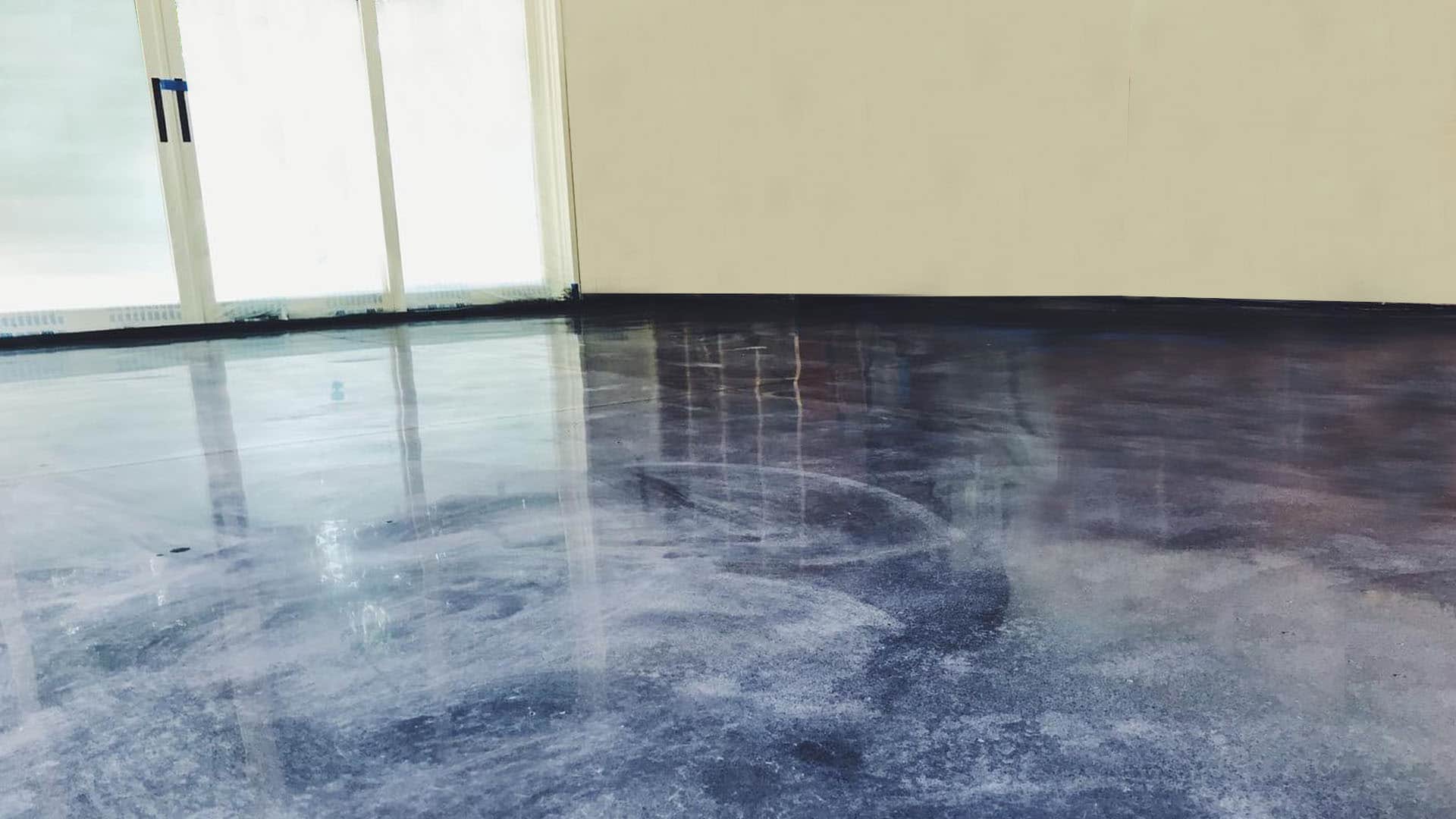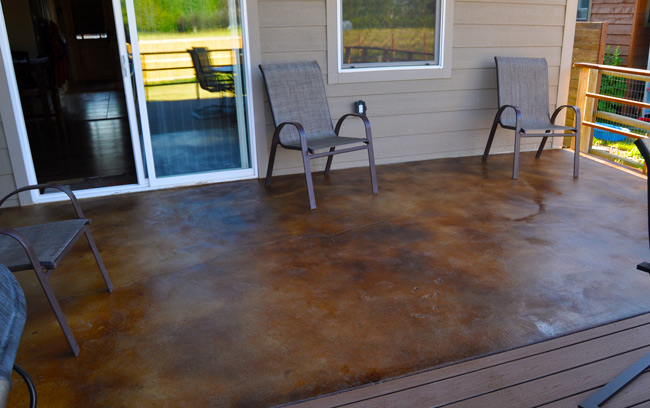How to evaluate a stained concrete company
All Regarding Stained Concrete: A Comprehensive Guide to Its Benefits and Applications
Stained concrete has actually emerged as a prominent selection for both household and industrial areas. Its capacity to combine aesthetic charm with functionality makes it an intriguing option. Various staining strategies provide a variety of shades and finishes, permitting customization. The advantages expand past appearance. Understanding its applications and maintenance needs is necessary for anybody considering this flexible material. The nuances of stained concrete welcome further exploration.
What Is Stained Concrete?

Staining can be put on different surface areas, including floors, driveways, and patios, making it a versatile alternative for both interior and outside areas. The therapy can accomplish a variety of looks, from earthy tones to strong, modern-day styles. Unlike paint, stained concrete maintains its look in time, as it ends up being an essential component of the concrete itself. In general, stained concrete functions as an effective technique for changing regular concrete into visually striking surface areas.
Advantages of Stained Concrete
Stained concrete deals substantial advantages, particularly in aesthetic appeal and durability - stained concrete contractors. Its vibrant shades and distinct patterns improve the aesthetic charm of any kind of room, making it a prominent choice for both domestic and commercial applications. Additionally, the durability of stained concrete assurances that it continues to be a useful investment over time, resisting wear and tear
Visual Charm
One of the most compelling advantages of utilizing stained concrete is its impressive visual appeal. Stained concrete deals an one-of-a-kind and versatile appearance that can enhance different style styles, from modern to rustic. The infusion of vivid colors and complex patterns allows property owners and designers to develop tailored surfaces that can improve the total setting of a room. Unlike traditional floor covering alternatives, stained concrete can resemble the appearance of natural rock or refined marble, supplying an upscale appearance without the linked costs. Furthermore, the shiny coating alternatives can show light, more brightening insides. This adaptability makes stained concrete a popular option for both property and commercial applications, where visual impact is vital.
Durability and Longevity
The outstanding aesthetic high qualities of stained concrete are enhanced by its amazing resilience and longevity - stained concrete company. Stained concrete surface areas are resistant to damage, making them ideal for high-traffic locations both indoors and outdoors. Their robust nature implies they can withstand rough climate problems, including severe temperature levels, rainfall, and UV direct exposure, without substantial degradation. In addition, stained concrete calls for minimal maintenance compared to various other flooring options, as it does not need constant securing or redecorating. This long life not only lowers replacement costs but also adds to a lasting structure approach. Generally, stained concrete provides a long-lasting option that integrates aesthetic appeal with practical advantages, ensuring its worth gradually
Various Kinds Of Staining Techniques
Different staining techniques can substantially influence the aesthetic high qualities of concrete surfaces. The 3 key approaches include acid staining, which reacts chemically with the concrete, water-based discoloration, which supplies a more comprehensive variety of colors, and overlay staining alternatives that give a fresh surface area. Each strategy has special features and applications that accommodate different design choices and job needs.
Acid Staining Method
Just how can homeowners change plain concrete surface areas right into visually striking functions? One effective method is acid staining, a prominent method that improves the all-natural elegance of concrete. This procedure entails using a remedy of water, hydrochloric acid, and metallic salts to the concrete surface area. As the acid responds with the lime present in the concrete, it creates abundant, variegated shades that look like marble or rock. Acid discoloration is recognized for its durability and resistance to fading, making it a resilient selection for both interior and outside applications. However, it is important to keep in mind that the results can vary based upon the initial concrete color and structure - local Clicking Here stained concrete. Correct application and securing are essential for attaining the preferred visual and long life
Water-Based Discoloration Method
A preferred choice to acid discoloration, the water-based staining method uses home owners a versatile means to enhance concrete surface areas. This technique uses water-soluble dyes and pigments, permitting for a wide variety of colors and coatings. Unlike acid discolorations, water-based discolorations can be put on unsealed concrete and use a simpler cleanup procedure. The results can achieve a much more uniform appearance and can be layered to create one-of-a-kind results. Additionally, water-based stains are usually much less hazardous and produce less unstable natural substances (VOCs), making them a lot more eco friendly. House owners might value the capacity to personalize their concrete surface areas with numerous tones, enabling imaginative expression while keeping toughness and long life in their floor covering choices.
Overlay Discoloration Options
Countless overlay discoloration alternatives exist for house owners seeking to rejuvenate their concrete surfaces. One popular selection is acid discoloration, which reacts chemically with the concrete to generate rich, variegated shades. An additional choice is water-based discoloration, offering a wider color combination and easier application. Additionally, concrete overlays can be incorporated with stencils for detailed layouts, enhancing aesthetics. For a more distinctive coating, homeowners might consider using stamped overlays that resemble all-natural products like stone or tile. Each technique gives unique advantages, from durability to customization, enabling an individualized touch. Eventually, the choice of overlay staining depends upon the desired appearance and the condition of the existing concrete, making certain a rejuvenated and enticing surface area.
Applications of Stained Concrete
Stained concrete deals a flexible service for numerous applications, enhancing both visual charm and functionality. This material is frequently used in household, commercial, and commercial settings, making it a prominent choice among designers and designers. In homes, stained concrete can act as fashionable flooring or exterior patios, providing a sophisticated look while continuing to be durable.
In commercial rooms, such as retail stores and dining establishments, stained concrete adds to a modern setting and can endure heavy foot web traffic. Furthermore, stained concrete is increasingly utilized in public spaces like my sources parks and sidewalks, where its capability to simulate all-natural stone or various other materials adds visual rate of interest.
Stained concrete is suitable for swimming pool decks and driveways, providing a slip-resistant surface area that is simple to keep. On the whole, the adaptability of stained concrete makes it ideal for countless settings, dealing with diverse preferences and requirements.
Upkeep and Treatment for Stained Concrete
Proper upkeep guarantees the long life and charm of stained concrete surface areas. Routine cleansing is crucial; using a mild cleaning agent and water with a soft-bristle brush helps eliminate dust and grime without harming the surface. It is suggested to stay clear of rough chemicals that can remove the stain or sealant.
Securing stained concrete is essential for security against moisture, discolorations, and wear. A high-quality sealant needs to be reapplied each to 3 years, moved here depending on the website traffic and exposure the surface sustains. Furthermore, resolving spills without delay will protect against discoloration and staining.

Expense Considerations for Stained Concrete Projects
When planning a stained concrete job, spending plan considerations play an important role in identifying the overall expense. The expenditures connected with stained concrete can vary significantly based on numerous aspects. First, the size of the area to be stained straight affects product and labor expenses. Bigger areas will naturally need more resources. Second, the kind of tarnish chosen-- acid-based or water-based-- can affect prices, with acid stains commonly being much more costly. Additionally, the complexity of the style, consisting of patterns or multiple shades, can enhance labor expenses. Preparation work, such as cleansing and grinding the concrete surface, adds to the preliminary expenses. Finally, the selection between do it yourself setup and employing a specialist contractor will certainly better impact the spending plan. Understanding these variables allows house owners to make educated economic choices regarding their stained concrete projects, ensuring they accomplish the wanted aesthetic within their economic methods.
Tips for Choosing the Right Stained Concrete for Your Room
Picking the right stained concrete for a particular area entails careful contemplation of various aspects beyond just budget plan. One must review the designated use of the area. High-traffic zones may require even more resilient finishes, while ornamental applications can prioritize aesthetics.
The color scheme is another essential facet; the selected colors should integrate with existing style and illumination. It's additionally vital to take right into account the surface appearance, as smooth surfaces can improve sophistication, while textured alternatives may guarantee safety and security in wet locations.
Regional environment and ecological problems play a significant role in the durability and maintenance of stained concrete, affecting the selection of sealants and finishes.
Finally, talking to experts can supply important insights tailored to certain requirements, ensuring the choice of the suitable stained concrete that straightens with both performance and design.

Frequently Asked Inquiries
Can Stained Concrete Be Applied Over Existing Floor Covering?
Stained concrete can undoubtedly be used over existing floor covering, offered the surface is stable and sufficiently prepared. This method enables an aesthetic upgrade without the requirement for total removal of the initial floor covering products.
How Much Time Does Stained Concrete Last?
Stained concrete can last for decades when appropriately preserved. Aspects such as traffic, environmental problems, and application methods substantially influence its longevity, with numerous installments staying vibrant and undamaged for 10 to thirty years.
Is Stained Concrete Slippery When Wet?
Stained concrete can be slippery when wet, as the surface might produce a smooth surface area. Nevertheless, using non-slip ingredients or textured finishes can mitigate this problem, boosting safety without compromising the aesthetic allure of the concrete.
Can I Stain Concrete Myself, or Should I Employ a Professional?
The decision to discolor concrete directly or work with a professional joints on ability degree and task intricacy. While DIY staining can save cash, professionals guarantee suitable outcomes, especially for intricate styles or huge surface areas.
What Color styles Are Offered for Stained Concrete?
The variety of shades readily available for stained concrete includes earthy tones like browns and tans, lively shades such as reds and blues, and softer shades like pastels. This palette enables creative, individualized design alternatives.